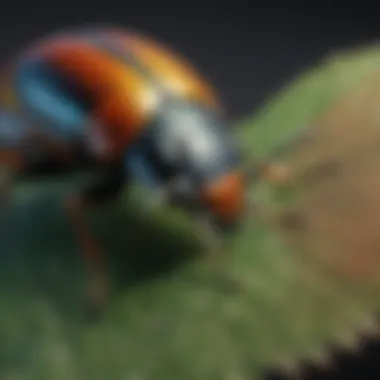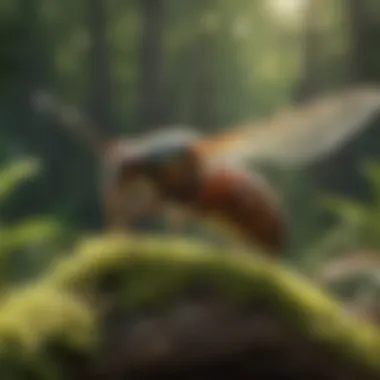Identifying Bugs in Pennsylvania: A Comprehensive Guide


Intro
In Pennsylvania, an incredible variety of insect species thrive. From those that benefit the environment to those that can cause significant damage to your home or garden, understanding these creatures is essential. This guide aims to equip you with knowledge about identifying these insects, their life cycles, and effective pest management strategies. This information can help homeowners, gardening enthusiasts, and professionals make informed decisions about how to deal with various insect species found in this region.
Understanding the Pest
Identification
Correctly identifying insects is the first step in managing them. Pennsylvania is home to both beneficial insects, like ladybugs, and pests, like aphids. The key is to recognize their features, behaviors, and habitats. For example, many beetles have distinct colors and shapes that can help identify varieties such as the Japanese Beetle or the Lady Beetle. Pay attention to the following details:
- Size and shape of the insect
- Color patterns and markings
- Wing structure
- Antennae type
You can use guides or smartphone apps specifically designed for insect identification, which provide details about local species. Resources such as Wikipedia can also help you to understand more about specific insects and their ecological roles.
Life Cycle
Understanding the life cycle of insects can aid in effective identification. Most insects go through several stages, including egg, larva, pupa, and adult. For example, the cicada undergoes an interesting life cycle, which can last up to 17 years before emerging as an adult. Knowing these cycles helps in timing pest control methods. Some insects emerge seasonally, while others may be active year-round, impacting their management strategies.
Pest Prevention Strategies
Environment Modification
One of the most effective ways to prevent insect infestations is through environmental management. Simple modifications around your home can significantly reduce insect attraction. Consider the following strategies:
- Maintain cleanliness in gardens and yards.
- Ensure proper drainage to avoid stagnant water, which attracts mosquitoes.
- Keep plants healthy to prevent pests from taking hold.
Physical Barriers
Using barriers can provide an extra level of protection against unwanted insects. Screens on windows and doors can prevent insects from entering your home.
- Install fine mesh screens to keep out small insects.
- Use row covers to protect plants from pests while allowing light and rain in.
Implementing these barriers can create a more peaceful environment.
Control Methods
Chemical Control
When prevention fails, chemical control methods may be necessary. Pesticides can target specific pests but must be used responsibly to avoid harming beneficial insects or local wildlife. Always follow the product instructions precisely and consider non-toxic alternatives when possible. Research options, such as those available at stores like Home Depot, that focus on eco-friendly practices.
Biological Control
An alternative to chemical solutions is biological control. This involves using natural predators to manage pest populations. For example, introducing ladybugs can help control aphid populations in gardens. When opting for this method, ensure the chosen predators are compatible with your local ecosystem.
Using integrated pest management approaches combines prevention, control, and monitoring to create an effective long-term strategy.
In summary, identifying insects in Pennsylvania requires understanding their species, life cycles, and control methods. This knowledge not only helps in managing pests effectively but also contributes to maintaining healthy ecosystems. Equip yourself with these insights to make informed decisions about pest management and ecological practices.
Prelims to Insect Identification in Pennsylvania
Understanding the diversity of insect species in Pennsylvania becomes essential for various reasons. Many people in suburbs or rural areas encounter insects daily, whether in gardens or homes. Proper identification can minimize risks while also promoting healthy ecosystems. Insects play significant roles, and recognizing these can help everyone, from homeowners to gardening enthusiasts, manage their environments better.
The Importance of Accurate Bug Identification
Accurate bug identification is integral for effective pest management. Every insect has unique characteristics, life cycles, and roles within its ecosystem. Not all bugs are harmful; in fact, many are beneficial. For instance, ladybugs are known to control aphid populations, making them allies in gardening. By understanding which insects to embrace or eliminate, homeowners can reduce pesticide usage, promoting a healthier garden.
"Identifying insects accurately leads to more sustainable gardening practices and healthier ecosystems."
Being able to distinguish between harmful pests and beneficial insects is also valuable for informed decision-making. A rash use of pesticides can lead to collateral damage, affecting good bugs as well as the targeted pests. Therefore, knowing which insect species are present can guide effective and eco-friendly pest management strategies.
Impacts on Ecosystems and Agriculture
Insects influence our ecosystems and agricultural practices extensively. They are pollinators, decomposers, and prey for various animals. Pollinators, like bees and butterflies, facilitate the reproduction of many flowering plants. Their presence directly ties to agricultural yields, as many crops depend on these insects for production.


On the other hand, harmful insects can devastate crops. For example, the Spotted Lanternfly, an invasive species, has profound impacts on fruit trees and ornamental plants. Recognizing such threats early allows for preventative measures, safeguarding both personal gardens and broader agricultural interests.
Insects also serve as indicators of environmental health. A pest-dominated landscape often signals imbalances in the ecosystem. Therefore, identifying and understanding these creatures not only helps in managing personal spaces but also contributes to the overall ecological balance we strive to maintain.
Common Bug Species in Pennsylvania
Understanding common bug species in Pennsylvania is crucial for several reasons. These insects play significant roles in ecosystem functioning, pollination, and pest control. By knowing which species are prevalent in the region, individuals can make informed decisions regarding pest management in their homes or gardens. Moreover, correct identification can also enhance appreciation for biodiversity and the complex interactions within ecosystems. This section highlights six specific groups of bugs that are frequently encountered in Pennsylvania, offering insights into their characteristics and importance.
Ants: Social Structures and Identification
Ants are remarkable insects known for their highly structured societies. They represent a diverse group, with over 100 species identified in Pennsylvania alone. Identifying ants typically involves observing their size, color, and the shape of their mandibles. Most ants are social insects, forming colonies that may include thousands of individuals. Some common species include the Carpenter Ant and the Pavement Ant. The distinction between these species can often be made by examining nesting habits and behavior.
Ants serve various ecological functions. They aerate the soil, help decompose organic matter, and can even control pest populations. Recognizing some key characteristics will greatly aid in identification and understanding their role in the environment.
Beetles: Diversity and Characteristics
Beetles are one of the most diverse groups of insects in Pennsylvania, boasting over 1,500 species. Their diversity is reflected in their physical characteristics, habitat preferences, and roles within ecosystems. Common beetles like the Ladybug and the Japanese Beetle differ significantly in appearance and behavior.
To identify beetles, focus on body shape, color patterns, and the presence of distinct markings. Beetles are vital in controlling agricultural pest populations and fostering plant health through pollination and decomposition. Understanding their habitat preferences and life cycles will deepen knowledge about their contributions to local ecosystems.
Butterflies and Moths: Aesthetic and Ecological Roles
Butterflies and moths are not only beautiful but essential for pollination. In Pennsylvania, notable examples include the Eastern Tiger Swallowtail and the Luna Moth. These insects have fascinating life cycles, transitioning through various stages from egg to caterpillar to adult. Observing their flight patterns can also aid in identification.
They play a crucial role in food webs, serving as prey for birds and other insects. Furthermore, their presence often indicates a healthy environment. It is vital to recognize their differences; butterflies typically fly during the day, while moths are primarily nocturnal. Appreciating these distinctions can foster a greater respect for their ecological roles.
Flies: Importance and Identification Challenges
Flies are diverse and can often be misunderstood. While some species are beneficial, like the Hoverfly, which pollinates flowers, others may be pests. Identification can be tricky due to their similar structures. Key identifiers include body shape, wing patterns, and behaviors.
Flies can have both positive and negative impacts on agriculture, thus understanding their roles is essential for effective pest management. Despite their challenges, being able to identify beneficial flies offers an advantage in maintaining garden health.
Wasps and Bees: Identification and Benefits
Wasps and bees are beneficial insects crucial for pollination. Honeybees and Yellowjackets are common examples found in Pennsylvania. While both groups can be mistaken for each other, bees usually have a more robust body, while wasps have a narrow waist.
These insects play vital roles in maintaining biodiversity and food production. Awareness of their lifecycle and behaviors enhances the ability to manage them in urban settings. Their role in pollination directly impacts agricultural yield and garden health, making their identification significant for homeowners and gardeners alike.
Summary
Identifying common bug species in Pennsylvania allows for greater understanding and interactions with the local ecosystem. Knowledge of ants, beetles, butterflies, moths, flies, and wasps facilitates better pest control strategies and promotes ecological health.
"Proficient bug identification enhances pest management and supports ecological conservation."
Gaining familiarity with these insects will help homeowners and gardening enthusiasts create harmonious living environments. Further exploration of these insects will enrich one’s appreciation for biodiversity.
Identification Techniques for Bugs
Identifying bugs correctly is crucial for managing pest populations and appreciating local biodiversity. This section outlines various techniques that help in accurate bug identification. Insects can greatly impact gardens, homes, and ecosystems. Therefore, understanding how to identify them can enhance one's approach to pest control and environmental awareness.
Using Field Guides and Apps
Field guides and mobile applications are valuable tools for anyone looking to identify insects. Field guides such as "The Audubon Society Field Guide to North American Insects and Spiders" provide photographic references and descriptions. Users can quickly compare the insects they encounter with the images in the guide. This approach is tactile and enriches the experience of learning.
Mobile apps like "Seek" engage users in real-time identification using the camera's capabilities. These apps leverage systemic databases to suggest species and provide additional information about their habitat and behavior. Using such tools not only increases knowledge but can enhance enjoyment for garden enthusiasts and homeowners.
Key Characteristics to Observe
When identifying insects, specific characteristics are essential. Observing the following elements can yield clues for accurate classification:
- Body Shape: Is it elongated, round, or flattened?
- Color and Patterns: What color is the insect? Does it have distinct patterns or markings?
- Wings: Are the wings present? How are they shaped?
- Antennae: What length and shape do the antennae have?
By systematically noting these features, one can narrow down the possible species. Even small differences can be significant in insect identification.


Understanding Insect Behavior
Insect behavior provides insight into their role in the ecosystem and assists with identification. Different species exhibit unique behaviors such as feeding patterns, mating rituals, and nesting habits. Take ants, for example; their foraging behavior and colony structure can help differentiate between species.
In recognition of their behaviors, here are a few aspects to observe:
- Feeding Habits: Is the insect feeding on plants, decaying matter, or predating on other insects?
- Movement Patterns: How fast does the insect move? Does it seem jittery or methodical?
- Interactions with Others: Assess how the insect interacts with its surroundings and other species.
Understanding these behaviors is vital in creating a holistic view of the species, assisting in effective pest management and appreciation for the ecosystem.
"Effective insect identification combines observing physical characteristics with understanding behaviors to ensure better pest control strategies."
Utilizing these identification techniques allows homeowners and gardening enthusiasts to engage more deeply with their local environment, fostering a greater appreciation for the insect world.
Regional Variations in Bug Populations
Understanding regional variations in bug populations is crucial. It provides insights into how different environments affect insect diversity in Pennsylvania. Geographic elements, such as topography and vegetation, along with climate conditions, influence where specific species thrive. Recognizing these patterns supports effective pest control and enhances biodiversity conservation. Moreover, knowledge of local populations helps homeowners manage their gardens and natural spaces better.
Influence of Climate on Insect Distribution
Climate plays a significant role in determining insect distribution across Pennsylvania. Temperature, precipitation, and seasonal changes impact when and where insects emerge. For instance, warm and moist environments promote higher insect activity. This makes spring and summer prime times for many species. Insects like cicadas and various beetles adapt their life cycles to changes in climate conditions.
Understanding these patterns can aid in predicting outbreaks or the arrival of new species. Homeowners can then prepare, using effective prevention methods.
Urban vs. Rural Environments
The contrast between urban and rural environments creates distinct insect populations in Pennsylvania. Urban areas are often transformed by human development, leading to habitat loss for many native insects. However, some species adapt well, such as pigeons and cockroaches, which thrive in cities. In rural areas, natural habitats remain more intact, allowing for diverse insect species to flourish.
Pest management strategies differ greatly. In urban settings, controlling invasive species like the emerald ash borer requires a different approach than in rural gardens filled with native flora. Understanding these dynamics is important for effective management. To summarize, recognizing regional variations helps in planning better practices for pest control and supports the preservation of local biodiversity.
Recognizing Beneficial vs. Harmful Bugs
Understanding the difference between beneficial and harmful insects is crucial for effective pest management. This knowledge allows homeowners and gardeners to protect their plants while maintaining a balanced ecosystem. Beneficial insects help control pest populations naturally. They can provide services like pollination or pest predation, essential for healthy gardens. On the contrary, harmful bugs may cause damage to crops or promote the spread of diseases. Recognizing these insects can prevent unnecessary chemical use, supporting eco-friendly gardening practices.
Natural Pest Controllers: The Role of Predators
Predatory insects play a significant role in maintaining garden health. For example, ladybugs are known for their appetite for aphids, which can devastate plants if uncontrolled. Wasps, particularly parasitic ones, can effectively reduce caterpillar numbers. This natural form of pest control helps minimize chemical treatments. Encouraging these beneficial insects by planting diverse flora can create a habitat that attracts them.
Furthermore, understanding the lifecycle and behavior of these predators aids in their identification. When spotting a ladybug, look for its distinct spots and round shape. Knowing such details enables gardeners to recognize their allies easily. Protecting these beneficial species leads to healthier pest control solutions, benefiting overall garden biodiversity and productivity.
Identifying Harmful Insects in Gardens
Identifying harmful insects is of equal importance as recognizing friendly bugs. Common harmful insects include aphids, caterpillars, and spider mites. Their damage to plants can vary from minor to severe, affecting plant health significantly. For instance, aphids tend to cluster on new growth, sucking sap and weakening plants. Spotted early, infestations can be managed using a variety of control methods.
To identify harmful insects, observe:
- Plant Damage: Look for signs like wilting, yellowing, or holes in leaves.
- Insect Presence: Monitor for clusters of small insects, webs, or droppings.
- Patterns: Understand that certain insects prefer specific plants. Knowing these preferences can aid in prevention.
A focused approach to detecting and managing harmful insects allows for timely interventions, reducing their impact on gardens. This proactive stance is essential for maintaining the integrity of local ecosystems.
Recognizing the roles insects play, both beneficial and harmful, facilitates informed decision-making in pest management strategies.
Pest Management Strategies
Pest management is not just about eliminating insects that pose threats. It encompasses a broader understanding of how to manage these creatures effectively and sustainably. This section emphasizes the need for balanced strategies when dealing with insect populations, particularly in Pennsylvania. Knowing the characteristics and behaviors of local bugs helps in crafting thoughtful solutions that can benefit ecosystems as well as human needs. The aim is to minimize harm while maximizing efficiency in management practices.
Ecological Approaches to Insect Control
Ecological approaches focus on remedying pest issues through natural means. By understanding the ecosystem, we can utilize beneficial insects and other biological agents. For example, ladybugs and lacewings can be valuable predators of aphids, making them vital in garden ecosystems. Applying ecological methods often requires observing the existing insect population and understanding their roles.
Some effective ecological strategies include:
- Promoting biodiversity: Diverse gardens support a variety of insect species. This encourages a natural balance, where beneficial insects keep harmful pests in check.
- Habitat enhancements: Planting native species can attract pollinators while deterring pest populations. This not only enriches the garden but also supports local wildlife.
- Companion planting: Certain plants can repel pests naturally or attract beneficial insects. For example, marigolds are known to deter nematodes and other unwanted bugs.


Using these approaches leads to healthier gardens and reduces reliance on pesticides. However, integrating them into your pest management plan requires patience and observation.
Chemical Methods: Risks and Considerations
While chemical methods can be effective in controlling insect populations, they come with significant considerations. The use of pesticides must be approached with caution. Over-reliance on these chemicals can lead to numerous issues: resistance in insect populations, harm to beneficial insects, and potential contamination of soil and water sources.
When considering chemical methods, reflect on:
- Types of pesticides: Understand the difference between systemic and contact pesticides. Systemic pesticides are taken up by plants and can affect non-target insect species.
- Timing of application: Proper timing can enhance effectiveness while minimizing harm. Applying during peak pest activity is crucial for impact.
- Targeted use: Avoid blanket applications. Identify affected areas and apply treatments selectively to limit collateral damage.
Here’s a list of best practices for chemical use:
- Always read labels carefully to understand active ingredients and safety measures.
- Follow guidelines concerning human and pet safety.
- Consider alternative approaches first before turning to chemicals.
Effective pest management is about finding harmony. Understanding and cooperating with nature will yield the best results in the long run.
Resources for Further Learning
Learning about bug identification in Pennsylvania is a continuous journey. Resources are essential for anyone seeking to deepen their knowledge and improve skills. They offer a wealth of information about various insect species, habitats, and behaviors. Accurate identification can lead to better pest management and an understanding of ecological roles. Here are two significant areas of resources: online databases and local services that provide valuable education and support.
Online Databases and Websites
Several online databases and websites serve as excellent repositories for insect information. These platforms can enhance your understanding of the bugs in Pennsylvania. Here are some recommended resources:
- BugGuide.net: A user-friendly site where enthusiasts can share photos and information about bugs. This helps in locating specific species and sharing knowledge among users.
- iNaturalist: A community-driven platform that allows users to upload their observations. This can be useful to track sightings and identify various species. It also has tools for recognizing patterns in bug populations.
- The Penn State Extension website: It offers extensive resources on insect identification specific to Pennsylvania. There is a treasure trove of documents on pest management and ecological information.
These resources are beneficial for various audiences, from casual observers to serious hobbyists. They provide mechanisms for submitting findings and receiving input from other users. You can gain insights into regional differences and seasonal behaviors.
"Knowledge is power; understanding bugs leads to better choices in pest control and conservation practices."
Local Extension Services and Workshops
Local extension services play a vital role in educating communities about insects and pest management. They may organize interactive workshops and informational sessions that focus on local bugs. Participants get hands-on experience in identifying various species. These services are often available through universities like Penn State, which has strong agricultural and environmental programs.
Benefits of local services include:
- Personalized Guidance: Experts in these workshops often provide tailored advice on local insect challenges, addressing specific pest problems residents might face.
- Networking Opportunities: Engaging with other attendees can foster community connections. Participants can share knowledge and experiences, enriching their bug identification skills.
- Access to Field Trials: Some events include field trials where participants can observe insects in their natural habitat. This direct observation enhances identification skills and overall ecological understanding.
In summary, utilizing both online resources and local services is instrumental for anyone eager to improve their identification of bugs. This approach offers a balanced and comprehensive educational experience, bridging theoretical knowledge with practical application. Such resources support both pest control objectives and foster a deeper appreciation for Pennsylvania's diverse insect life.
Ending
The conclusion of this article serves a vital role in encapsulating the significance of understanding insect identification, especially for those living in Pennsylvania. Accurate identification of bugs is not just an academic exercise; it is central to effective pest management and the preservation of the state’s ecological balance.
When homeowners know the different species that inhabit their gardens, they can make informed decisions about pest control. Knowledge protects not only plants but also beneficial insects that contribute to pollination and pest regulation. For instance, homeowners might mistakenly classify a native bee as a harmful insect, leading to unnecessary elimination. This illustrates a clear benefit of informed identification.
Moreover, recognizing pest from non-pest insects can reduce reliance on chemical methods. By fostering a deeper understanding of Pennsylvania’s insect biodiversity, people can engage in ecological approaches to manage pests. Such practices promote sustainable gardening and contribute to a healthier environment.
"Informed identification is crucial to distinguish between beneficial and harmful insects, thereby supporting ecological health."
The Role of Informed Identification in Pest Management
Informed identification plays a critical role in pest management strategies. When individuals learn to differentiate between harmful and beneficial insects, they empower themselves to make informed choices. This knowledge can shift pest management from a reactive to a proactive approach.
First, educated identification can foster preventive measures. Homeowners who recognize the signs of insect activity can address issues before they escalate into infestation. For instance, monitoring plants for specific pests like the Japanese beetle allows for targeted interventions that minimize damage while also protecting beneficial insects.
Second, understanding the life cycles and behaviors of various insects enhances compliance with ecological pest control methods. For example, methods that encourage natural predators such as ladybugs or lacewings can be implemented, reducing the need for harmful chemicals. Educated individuals are better equipped to implement techniques that align with sustainable practices.
Lastly, informed identification fosters community engagement in pest management. Sharing knowledge with neighbors creates a collective understanding and cooperation toward maintaining healthy ecosystems.
Final Thoughts on Pennsylvania’s Insect Biodiversity
The diversity of insects in Pennsylvania is a reflection of the state’s rich ecosystems. From the agricultural fields in the south to the dense forests in the north, each region hosts a unique combination of species, all contributing to local biodiversity.
Understanding this diversity is crucial for homeowners and gardeners. First, it promotes a deeper appreciation for the environment, moving beyond mere identification to fostering a relationship with local wildlife. Engaging with the ecosystem encourages mindful practices that can protect not just gardens but also contribute to the overall health of the area.
Furthermore, being aware of the various insects available in Pennsylvania allows for better adaptation to changing environmental conditions. Knowledgeable homeowners can recognize shifts in insect populations that may indicate broader ecological impacts, prompting them to adjust their pest management strategies accordingly.
Ultimately, the insect biodiversity in Pennsylvania is an asset. By learning to identify and understand these species, homeowners can contribute to preserving their local environments while reaping the benefits of a balanced ecosystem.







